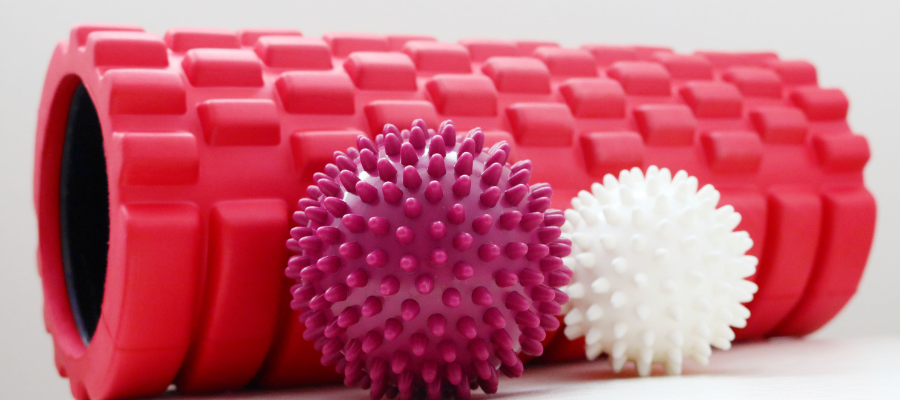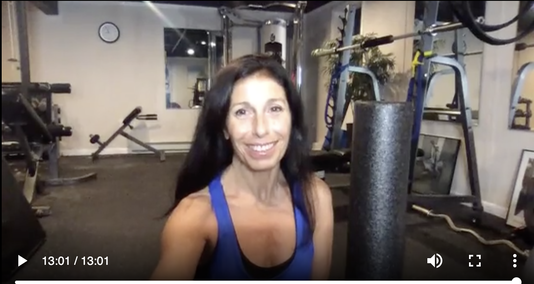|
A foam roller is a piece of hard-celled foam in the shape of a cylinder, or ball. It comes in different levels of densities from soft to hard, which allow different levels of pressure to be applied to your muscles. You can get them in 1’ or 3’ lengths or 6” – 8” posture balls. They could be smooth, ridged or …… and some even vibrate. You could even use a tennis ball to get at some hard to reach areas like behind the shoulder blades. Foam rolling is also called myofascial release and is done to work out the “knots” in your muscles, much like therapeutic massage or self-massage. The knots are myofascial adhesions that develop in our muscles through stress, overuse, movement imbalances or just everyday training. What Is Myofascial Release?The myofascial release is accomplished through the stimulation of sensory-motor receptors in the muscle and connective tissue. By using the foam roller over these areas, you are releasing adhesions and improving blood circulation as well as your ability to stretch. You can’t stretch a knot. If you want to improve flexibility, you need to release the knots first and then stretch. Stretching without working on the knots first will actually create tighter knots. Think of an elastic band tied in a knot. If you try to stretch the band, the area around the knot will stretch but the knot gets tighter; similar to what happens in your muscles. One session with a foam roller may not completely release a knot, but you will notice improvements. I recommend using a foam roller daily focusing on a different area each day. Unfortunately foam rolling can be a bit painful. Start out slowly and only put mild pressure on the area you are working. The more knots the more tenderness you’ll experience. The key to getting results from foam rolling is to be consistent. Spending just 5 minutes a day on an area of the course of a couple weeks will generate tremendous results. do you Foam roll Before or After a workout?There is not a lot of research to back up when to foam roll. I believe there are benefits to both. Foam rolling before a workout will help prepare the muscles for movement, increasing range of motion and circulation. After rolling, you should perform some static stretches and then complete a dynamic warm up. After the workout will aid in muscle recovery and prevent soreness. It’s also a nice way to quiet the body after an intense workout, followed of course by static stretching. How Do I Foam Roll?Using your own body weight, you simply roll back and forth over the targeted area. When you come to a tender spot, stay there for 30 – 60 seconds. Honestly, 60 seconds can seem like a very long time so work up to it. The tenderness should subside somewhat before moving on to the next area. Afterwards, perform static stretches; this will help to ensure the increase in flexibility will be long term. In the video below I show you how to use the foam roller for your hips, glutes, hip abductors and hip flexors. CLICK HERE TO WATCH THE VIDEO If you’d like to purchase a foam roller below is a link to my Amazon shop. I have a few of my favorites under the Exercise Equipment category. Remember to start off with a moderate density foam roller and work you way up to the harder surfaces.
http://amazon.com/shop/lisaswansonfit
0 Comments
Leave a Reply. |
authorLisa Swanson is an ACE Certified Health Coach, Personal Trainer and Orthopedic Exercise Specialist as well as a certified AASDN and PN level 1 nutritionist. With over 35 years experience helping people turn their lives around, she is on a mission to provide relevant and useful knowledge to help women in midlife reach their goals. featured onCheck out my interview with the Magnificent Midlife podcast on staying fit and healthy long-term.
Categories
All
|
What I DoAt Body & Soul Coaching I empower women over 50 to lose weight and feel confident without deprivation diets or spending hours in the gym.
|
Company |
|
|
© COPYRIGHT 2022. ALL RIGHTS RESERVED.
|
Website Design by My Personal Trainer Website
|




 RSS Feed
RSS Feed